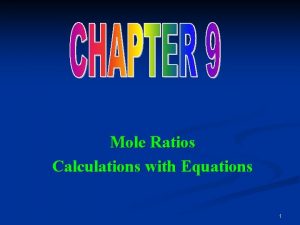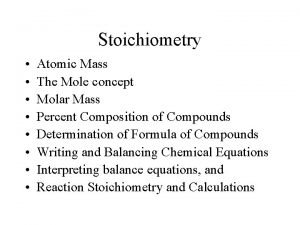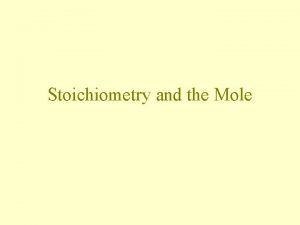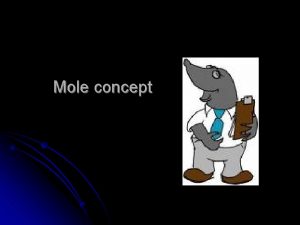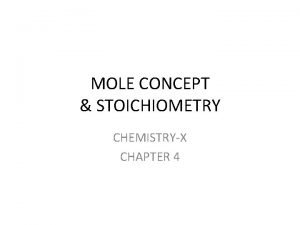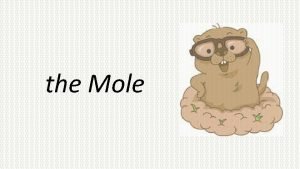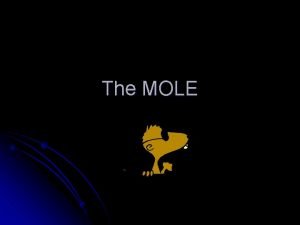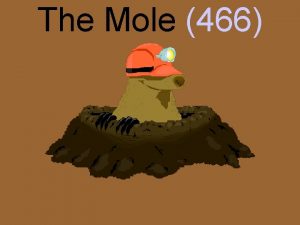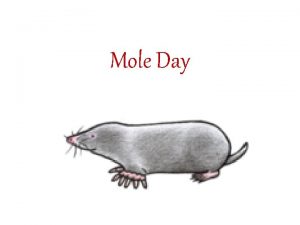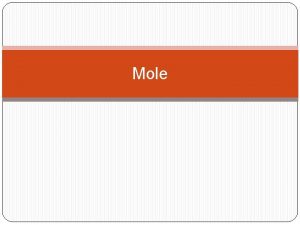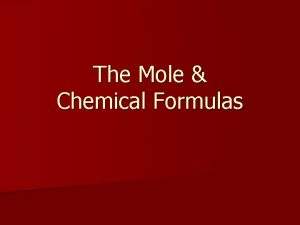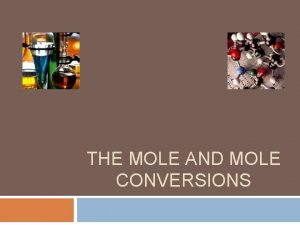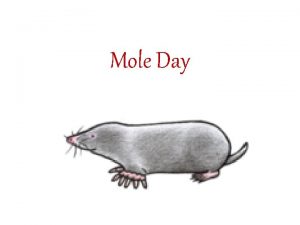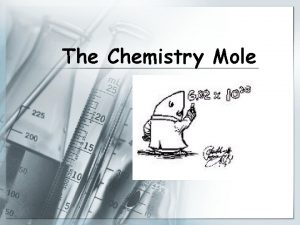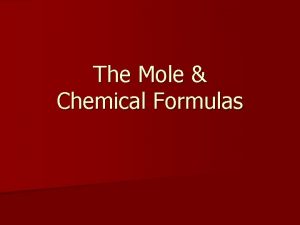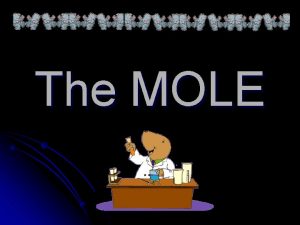Three Equations That Make The Mole Concept Ridiculously
















- Slides: 16

Three Equations That Make The Mole Concept Ridiculously Simple by Mr. K Click for more

The mole concept is the chemists way with dealing with amounts of STUFF called matter (compounds, molecules, atoms, ions, atomic particles, etc. ). The mole concept can be summarized by the (“mole triangle”) figure below. It shows the relations between moles of stuff (n. S), particles of stuff (p. S) and Avogadro's number (NA = 6. 022 x 1023 particles/mol), and mass of stuff (m. S) and molar mass of stuff (MS). Mole concept calculations for all stuff can be completely defined by the use of three equations derived from the “mole triangle. ” Click for more

The first equation shows that a mole of STUFF is equal to the mass of the stuff divided by the molar mass of the stuff. Any mole concept problem dealing with moles of stuff and mass of that stuff can be solved using this equation. Click for more

The second equation shows that a mole of stuff is equal to the number of particles of the stuff divided by Avogadro’s Number. Any mole concept problem dealing with moles of stuff and particles of that stuff can be solved using this equation. Click for more

The third equation shows the relation of mass of stuff and particles of the stuff. Any mole concept problem dealing with mass of a substance and particles of that substance can be solved using this equation. Click for more

It is a must that students memorize these three equations. All mole concept problems can be solved using the correct equation for the data given in a mole concept calculation. Click for more

To make mole concept calculations the student should follow three steps: First, carefully analyze the problem to determine the kind of information given in the problem (mole, mass, particles ? ? ), determine which of the three equations can be used to solve the problem, and write down the equation. Second, read the problem again and write the values of the known information given in the problem and the value of the unknown as equalities either under or beside the equation from the first step. Remember that Avogadro's number is always known, and molar mass can always be calculated from the formula of the compound, molecule, or ion given in the problem. Last, substitute the values of all of the variables determined in the second step into the equation determined in the first step and solve for the unknown using the method of solving a linear equation or ratio-and-proportion. Click for more

Example 1: How many molecules of C 4 H 10 O are in 0. 345 moles of C 4 H 10 O? Step 1––Analysis: This problem deals with particles (molecules) and moles–– equation (2) fits this problem with p. S being the unknown to be calculated. The equation is: Step 2––Variable Values: n. S = 0. 345 mol (of C 4 H 10 O) p. S = x (to be calcualted) NA= 6. 022 x 1023 molecules/mol Step 3––Solution: Click for more

Example 2: Determine the mass of 25 molecules of C 4 H 10 O. Step 1––Analysis: This problem deals with particles (molecules) and mass–– equation (3) fits this problem with m. S being the unknown to be calculated. The equation is: Step 2––Variable Values: Step 3––Solution: p. S = 25 molecules m. S = x (to be calculated) NA = 6. 022 x 1023 molecules/mol MS = 74. 0 g/mol (calculated from formula) Click for more

Example 3: How many moles of C 4 H 10 O are in 25. 6 g of C 4 H 10 O? Step 1––Analysis: This problem deals with mass and moles––equation (1) fits this problem with n. S being the unknown to be calculated. The equation is: Step 2––Variable Values: m. S = 25. 6 g (of C 4 H 10 O). n. S = x (to be calculated) MS = 74. 0 g/mol (calculated from formula) Step 3––Solution: Click for more

Example 4: 4. 56 billion molecules of C 4 H 10 O is how many moles of C 4 H 10 O? Step 1––Analysis: This problem deals with particles (molecules) and moles–– equation (2) fits this problem with n. S being the unknown to be calculated. The equation is: Step 2––Variable Values: n. S = x (to be calculated) p. S = 4. 65 billion molecules –– 4. 56 x 109 molecules NA= 6. 022 x 1023 molecules/mol Step 3––Solution: Click for more

Example 5: 98. 6 g of C 4 H 10 O contains how many molecules? Step 1––Analysis: This problem deals with particles (molecules) and mass–– equation (3) fits the problem with p. S being the unknown to be calculated. Step 2––Variable Values: m. S = 98. 6 g (of C 4 H 10 O) p. S = x (to be calculated) NA = 6. 022 x 1023 molecules/mol MS = 74. 0 g/mol (calculated from formula) Step 3––Solution: Click for more

Example 6: Determine the mass of 2. 03 moles of C 4 H 10 O. Step 1––Analysis: This problem deals with mass and moles––equation (1) fits the problem with m. S being the unknown to be calculated. The equation is: Step 2––Variable Values: n. S = 2. 03 moles m. S = x MS = 74. 0 g/mol (calculated from formula) Step 3––Solution: Click for more

Each of these examples is a typical mole concept calculation. The "triangle method" of deriving equations relating moles, mass and particles is simple to learn. The analysis of mole concept problems is easy and quickly mastered. Substituting known and unknown information into the equation derived to solve a problem leaves a linear equation or ratio-and-proportion calculation that students should easily be able to simplify and solve. Click for more

The “Mole Triangle” Click to END

The “Mole Triangle” Bye
 Stoichiometry: mole-mole problems
Stoichiometry: mole-mole problems Mole mole factor
Mole mole factor Stoichiometry worksheet #2 (mole-mass mass-mole problems)
Stoichiometry worksheet #2 (mole-mass mass-mole problems) Phosphorus + oxygen equation
Phosphorus + oxygen equation Stoichiometry mole-mole
Stoichiometry mole-mole Grams to moles formula
Grams to moles formula Mole mass and mole volume relationships
Mole mass and mole volume relationships Phân độ lown
Phân độ lown Block av độ 1
Block av độ 1 Thể thơ truyền thống
Thể thơ truyền thống Thơ thất ngôn tứ tuyệt đường luật
Thơ thất ngôn tứ tuyệt đường luật Walmart thất bại ở nhật
Walmart thất bại ở nhật Tìm vết của mặt phẳng
Tìm vết của mặt phẳng Hãy nói thật ít để làm được nhiều
Hãy nói thật ít để làm được nhiều Tôn thất thuyết là ai
Tôn thất thuyết là ai Gây tê cơ vuông thắt lưng
Gây tê cơ vuông thắt lưng Sau thất bại ở hồ điển triệt
Sau thất bại ở hồ điển triệt

